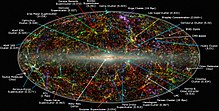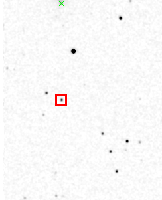astro.wikisort.org - Book
The Two Micron All-Sky Survey, or 2MASS, was an astronomical survey of the whole sky in infrared light.[1] It took place between 1997 and 2001, in two different locations: at the U.S. Fred Lawrence Whipple Observatory on Mount Hopkins, Arizona, and at the Cerro Tololo Inter-American Observatory in Chile, each using a 1.3-meter telescope for the Northern and Southern Hemisphere, respectively.[2] It was conducted in the short-wavelength infrared at three distinct frequency bands (J, H, and K) near 2 micrometres, from which the photometric survey with its HgCdTe detectors derives its name.[1]
 | |
| Alternative names | Two Micron All-Sky Survey |
|---|---|
| Website | www |
| | |

2MASS produced an astronomical catalog with over 300 million observed objects, including minor planets of the Solar System, brown dwarfs, low-mass stars, nebulae, star clusters and galaxies. In addition, 1 million objects were cataloged in the 2MASS Extended Source Catalog (2MASX). The cataloged objects are designated with a "2MASS" and "2MASX"-prefix respectively.
Catalog
The final data release for 2MASS occurred in 2003,[3] and is served by the Infrared Science Archive. The goals of this survey included:
- Detection of galaxies in the "Zone of Avoidance", a strip of sky obscured in visible light by our own galaxy, the Milky Way.
- Detection of brown dwarfs. 2MASS discovered a total of 173, including 2MASS 0939-2448, 2MASS 0415-0935, 2M1207, and 2MASS J04414489+2301513.[4]
- An extensive survey of low mass stars, the most common type of star both in our own galaxy and others.
- Cataloging of all detected stars and galaxies.
- Infrared measurements from the 2MASS survey have been particularly effective at unveiling previously undiscovered star clusters.[5][6]
Numerical descriptions of point sources (stars, planets, asteroids) and extended sources (galaxies, nebulae) were cataloged by automated computer programs to an average limiting magnitude of about 14. More than 300 million point sources and 1 million extended sources were cataloged. In November 2003, a team of scientists announced the discovery of the Canis Major Dwarf Galaxy, at that time the closest known satellite galaxy to the Milky Way, based on analysis of 2MASS stellar data.
The resulting data and images from the survey are currently in the public domain, and may be accessed online for free by anyone.[7] There is also a list of 2MASS science publications with links to free pre-publication copies of the papers.[8]
2MASS is sponsored by the University of Massachusetts Amherst, the Infrared Processing and Analysis Center (IPAC, run by Jet Propulsion Laboratory (JPL) and Caltech), NASA, and the National Science Foundation (NSF).
References
- "About 2MASS (A Brief Explanation of 2MASS)". University of Massachusetts, Infrared Processing and Analysis Center (JPL/ Caltech), NASA, NSF. 2006-02-01. Retrieved 2008-09-21.
- "Two Micron All Sky Survey (2MASS)". NASA/IPAC Infrared Science Archive. Retrieved 2011-10-22.
- 2MASS Helpdesk. "2MASS All-Sky Data Release FAQ Page". old.ipac.caltech.edu. Caltech. Retrieved 14 December 2018.
- Kirkpatrick, J. Davy (2003). "2MASS Data Mining and the M, L, and T Dwarf Archives". IAU Symposium Vol. 211 ("Brown Dwarfs") (PDF). Vol. 211. arXiv:astro-ph/0207672v1. Bibcode:2003IAUS..211..189K.
- Froebrich, D.; Scholz, A.; Raftery, C. L. (2007). A systematic survey for infrared star clusters with |b| <20° using 2MASS, MNRAS, 347, 2
- Majaess, D. (2013). Discovering protostars and their host clusters via WISE, ApSS, 344, 1
- "2MASS Data Access". The Two Micron All Sky Survey at IPAC. December 20, 2006. Retrieved September 2, 2012.
- "2MASS Science Publications". The Two Micron All Sky Survey at IPAC. February 1, 2006. Retrieved September 2, 2012.
External links
- 2MASS at IPAC
- 2MASS at UMass
- 2MASS Atlas Image Gallery: Miscellaneous Objects
- Low-Mass Stars and Brown Dwarfs in 2MASS
- 2MASS All-Sky Release Database
На других языках
[de] Two Micron All Sky Survey
In der Infrarotastronomie ist der Two Micron All Sky Survey (kurz 2MASS genannt) eine wichtige Durchmusterung des gesamten Himmels im nahen Infrarotbereich Die Sensoren hatten ihre Wellenlänge maximaler Empfindlichkeit bei- [en] 2MASS
[es] 2MASS
2MASS (Two Micron All-Sky Survey, Reconocimiento en dos micrómetros de todo el cielo[1]) es el proyecto encaminado a crear un planisferio del cielo nocturno más ambicioso hasta la fecha. Las observaciones empezaron en el año 1997 y se completaron el año 2001. Fueron realizadas con dos telescopios situados uno en el hemisferio norte y el otro en el hemisferio sur (en el Monte Hopkins Arizona y en Cerro Tololo/CTIO Chile, respectivamente) con la finalidad de abarcar el cielo completo. La fecha del lanzamiento del 2MASS, después del post-procesado de los datos, se produjo en el año 2003. En el transcurso de las observaciones se inspeccionó todo el cielo usando sistemas fotométricos en tres bandas infrarrojas recorriendo los 2 micrómetros ( μ {\displaystyle \mu } m): J (1,25 μ {\displaystyle \mu } m), H (1,65 μ {\displaystyle \mu } m), y Ks (2,17 μ {\displaystyle \mu } m).[ru] 2MASS
2MASS (англ. Two Micron All-Sky Survey) — обзор всего неба на длине волны два микрона. Обзор неба в инфракрасном диапазоне, осуществлявшийся в 1997—2001 годах с помощью двух телескопов в северном полушарии (Обсерватория имени Уиппла, Аризона) и южном (Чили).Другой контент может иметь иную лицензию. Перед использованием материалов сайта WikiSort.org внимательно изучите правила лицензирования конкретных элементов наполнения сайта.
WikiSort.org - проект по пересортировке и дополнению контента Википедии